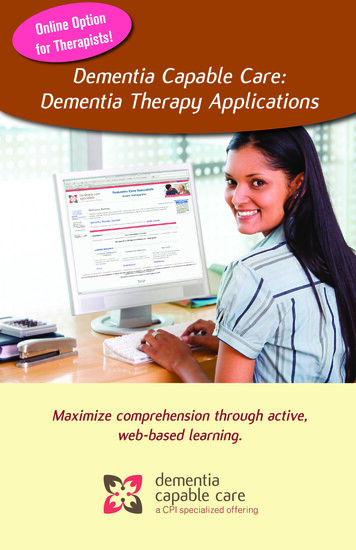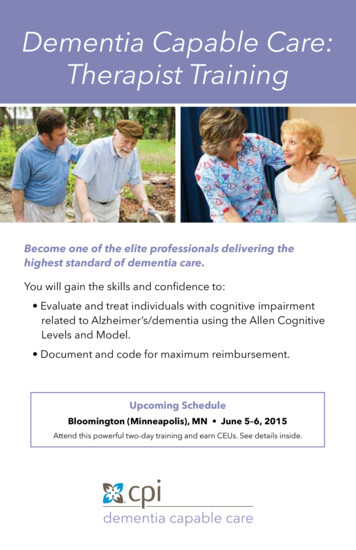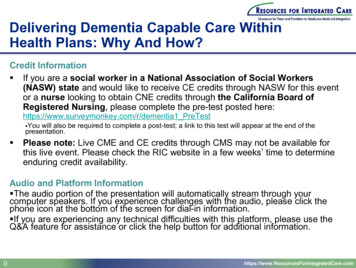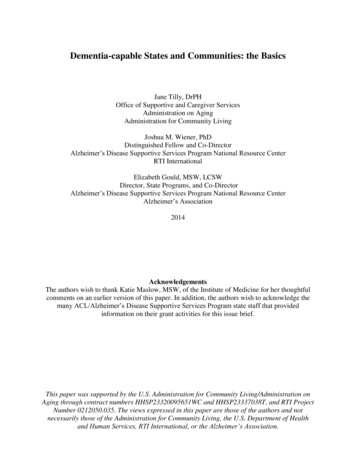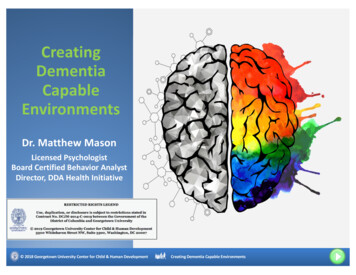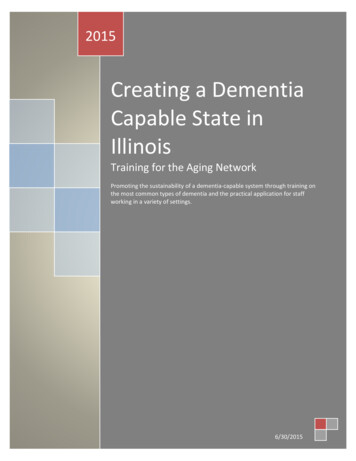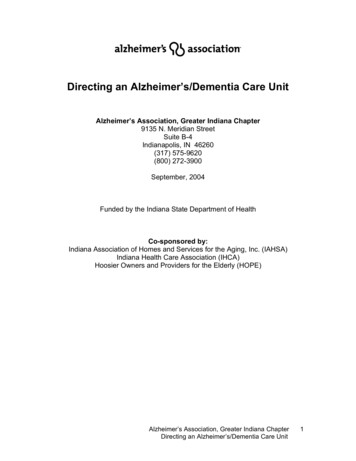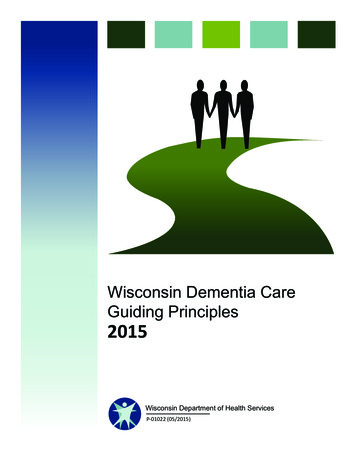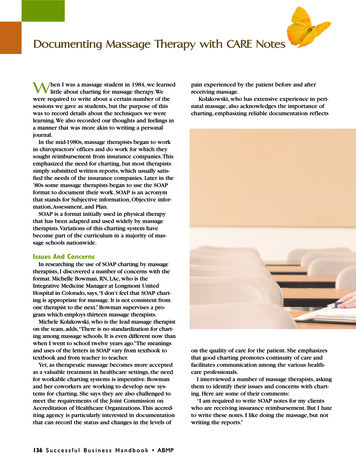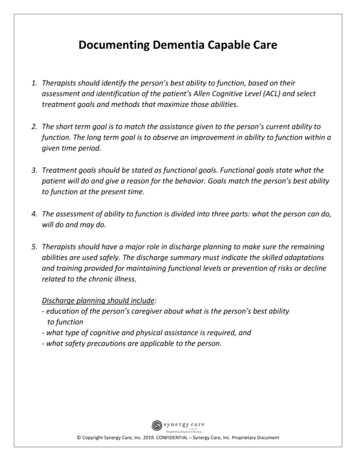
Transcription
Documenting Dementia Capable Care1. Therapists should identify the person’s best ability to function, based on theirassessment and identification of the patient’s Allen Cognitive Level (ACL) and selecttreatment goals and methods that maximize those abilities.2. The short term goal is to match the assistance given to the person’s current ability tofunction. The long term goal is to observe an improvement in ability to function within agiven time period.3. Treatment goals should be stated as functional goals. Functional goals state what thepatient will do and give a reason for the behavior. Goals match the person’s best abilityto function at the present time.4. The assessment of ability to function is divided into three parts: what the person can do,will do and may do.5. Therapists should have a major role in discharge planning to make sure the remainingabilities are used safely. The discharge summary must indicate the skilled adaptationsand training provided for maintaining functional levels or prevention of risks or declinerelated to the chronic illness.Discharge planning should include:- education of the person’s caregiver about what is the person’s best abilityto function- what type of cognitive and physical assistance is required, and- what safety precautions are applicable to the person. Copyright Synergy Care, Inc. 2019. CONFIDENTIAL – Synergy Care, Inc. Proprietary Document
1Goal ExamplesLTG:PT/OT/ST(DCCLTG) (Who) will (reason for referral/problem) with (BATF-cog and physical assistance) provided (who?) to (prevent,minimize or maintain) within (timeframe)STG:PT-OT-ST(ACL1) Pt will respond to (sensory stimulation) with automatic actions of (desired action) to prevent or minimize (reasonfor referral/problem), with sensory stimulation provided by a competent caregiver.PT(ACL2PT) Pt will transfer with (verbal, visual and/or tactile) cues and minimum physical assist, as provided by acompetent caregiver.(ACLLow3PT) Pt will ambulate from resident room to dining room three times daily using a rolling walker with (verbal,visual and/or tactile) cues and minimum physical assist, as provided by competent caregiver.(ACLLow4PT) Pt will perform LE HEP with (verbal, visual and/or tactile) cues, and minimum physical assist, as provided bya competent caregiver.OT(ACL2OT) Pt will feed self with (level of cognitive assist) cognitive assist, as provided by a competent caregiver.(ACLLow3OT) Pt will perform oral hygiene with (level of cognitive assist) cognitive assist, as provided by a competentcaregiver.(ACLLow4OT) Pt will complete a morning ADL care routine with (level of cognitive assist) cognitive assist, as provided bya competent caregiver.ST(ACL1AwarenessSLP) The resident will respond to stimulation of environment sounds demonstrated through variationsin arousal or physical effect on ( out of occasions).(ACL2ST) Pt will identify target vocabulary used in ADLs in response to closed ended questions with (verbal, visual and/ortactile) cues, as provided by a competent caregiver.(ACL2.2NamingSLP) The resident will identify target vocabulary used in ADLs in response to open-ended responses orcloze techniques on ( out of occasions).(ACL2.6/8RepetitionSLP) The resident will produce familiar phrases in unison with the facilitator on ( out ofoccasions).
2Goal Examples(ACLLowSLP) Pt will state basic and/or social needs with (verbal, visual and/or tactile) cues, as provided by a competentcaregiver.(ACL3.4Language) The resident will generate simple phrases using verb ing constructions on ( out ofoccasions) while participating in ADLs or social events.(ACL3.8Expression) The resident will state basic and/or social needs when prompted with relevant content words orrevised verbal attempts on ( out of occasions).(ACLLow4SLP) Pt will generate a daily activity list with (verbal, visual and/or tactile) cues, as provided by competentcaregiver.(ACL4.2WhQuestions) The resident will respond to “wh” questions about anticipated or scheduled events usingvisual/graphic cues on ( out of occasions).(ACL4.8Memory) The resident will generate a daily activity list with minimal assistance over (number of days)consecutive days.(ACL4MemoryBook) Resident will utilize a memory book, which includes a daily activity schedule with (percentage)accuracy with intermittent verbal cues to increase orientation and decrease perseveration.(ACL4Attention) Resident to attend/concentrate on a structured tasks for 30-minute intervals with intermittent verbalcues for redirection.(ACL3ReceptiveLanguage) Resident to demonstrate functional usage of an ADL object appropriately for receptivelanguage ability with (percentage) accuracy, with extended time for processing and with environmental setup.(ACL3Naming) Resident will name three objects used during functional tasks with (percentage) accuracy with extendedtime for processing and with environmental setup.(ACL3Attention) Resident to attend/concentrate on a structured task for 15 minute intervals with intermittent verbal,visual and tactile cues for redirection and with environmental setup.(ACL2Singing)Resident will sing a refrain for a song with continuous auditory cues to strength vocal cords, increase lungcapacity and reduce risk of aspiration.(ACL2Attention) Resident to attend/concentrate on a structured tasks for five-minute intervals with constant verbal,visual and tactile cues for redirection and with environmental set-up.(ACL1SensoryStim) Resident will respond vocally to sensory stimulation three times per session with constant verbalcues to increase management of secretions/excretions.These examples are from the Dementia Capable Care: Dementia Therapy Applications book created by Kim Warchol- Dementia CareSpecialists/Crisis Prevention Institute.
1Goal Examples**Some goals may apply to more than one discipline**Grooming(Grooming3.0) Pt will grasp grooming objects. Caregiver will provide familiar safe objects and will cue with associatedaction.(Grooming3.2) Pt will initiate familiar actions of brushing, combing. Caregiver will supervise and provide assistance toavoid harmful effects, ensure effective results.(Grooming3.4) Pt will maintain grooming actions and cooperative with caregiver assistance. Caregiver will provide toolsand objects and appropriate supervision to avoid harmful or undesirable effects.(Grooming3.6) Pt will note effects and will imitate changes in location and duration of actions. Caregiver will supervise,provide appropriate assistance to avoid harmful effects.(Grooming3.8) Pt will recognize completion of grooming tasks. Caregiver will supervise and provide appropriateassistance to avoid harmful effects. Caregiver will arrange for long-term or special dental care.(Grooming4.0) Pt will complete familiar routine of grooming with assistance in set-up and to avoid harmful effects.Caregiver will provide familiar tools in accessible locations; will supervise use of new and potentially dangerous tools andmaterials. Will schedule dental check-ups.(Grooming4.2) Pt will complete familiar routine of grooming tasks with assistance to avoid harmful effects. Caregiver willassist with error correction and supervise use of harmful materials.(Grooming4.4) Pt will complete familiar routine of grooming with assistance to avoid harmful effects. Caregiver willassist with error correction and supervise use of harmful materials and new procedures and products.(Grooming4.6) Pt will complete familiar grooming routines with some variations from his or her standard performancewith assistance to avoid harmful or undesirable effects. Caregiver will assist with error correction and supervise use ofnew or potentially harmful products.(Grooming4.8) Pt will correct perceived errors one at a time in grooming tasks and will follow explanations of harmfulsecondary effects to be avoided in shaving, dental, nail and hair care. Caregiver will monitor use of new supplies andprovide explanations of potential hazards.(Grooming5.0) Pt will complete routine grooming care independently with assistance to avoid harmful effects in newtasks. Caregiver will explain secondary effect and provide assistance with spatial and surface properties.(Grooming5.2) Pt will complete routine grooming care independently with assistance to avoid harmful effects in newtasks. Caregiver will explain and provide secondary effects and provide assistance with spatial properties.(Grooming5.4) Pt will complete routine grooming care independently with assistance to avoid harmful effects in newtasks Caregiver will explain secondary effects and consequences of failing to consider social rules governing appearance.(Grooming5.6) Pt will complete routine grooming care independently with assistance to avoid harmful effects in newtasks. Caregiver will explain potential harmful secondary effects of new procedures/products.
2Goal ExamplesDressing(Dressing2.0) Pt will move arms, legs, trunk in response to cues to assist with dressing. Caregiver will dress pt, applyadaptive equipment to avoid medical complications.(Dressing2.2, .4, .6) Pt will push arms and legs through garments when cues to assist with dressing. Caregiver will dresspt, apply adaptive equipment to avoid medical complications.(Dressing2.8) Pt will use grab bars or other objects for stability while dressing. Caregiver will dress pt, apply adaptiveequipment to avoid medical complications.(Dressing3.0) Pt will grasp garments when these are handed to him/her. Caregiver will select and assist with donningclothes and adaptive equipment.(Dressing3.2) Pt will grasp and begin correct actions of donning familiar garments. Caregiver will select and assist withdonning clothes and adaptive equipment.(Dressing3.4, .6) Pt will complete dressing with caregiver assistance. Caregiver will provide appropriate assistance.Caregiver will provide appropriate assistance, check results and correct errors. Caregiver will monitor for correctadjustment of donned items.(Dressing3.8) Pt will dress self and recognize completion with assistance in selection and donning. Caregiver will provideassistance in selection and donning, will check results and correct errors. Will apply and adjust adaptive equipment.(Dressing4.0) Pt will initiate and complete dressing at customary time of day with assistance in selection and donning.Caregiver will provide assistance in selection and donning, will check results and correct errors. Will apply and adjustadaptive equipment.(Dressing4.2) Pt will select clothing based on matching cues and will don common garments independently. Caregiverwill provide assistance as necessary with new garments, fasteners, and will monitor and correct dressing errors.Caregiver will apply and monitor complex adaptive equipment.(Dressing4.4) Pt will initiate and complete dressing using familiar combinations of clothing with assistance with new anddifficult fasteners. Pt will apply simple splint or other devices with assistance. Caregiver will provide assistance asnecessary with new garments, fasteners, and will monitor and correct dressing errors. Caregiver will apply and monitorcomplex adaptive equipment.(Dressing4.6) Pt will dress self independently and will vary combinations one feature at a time. Will apply simple splintsor pre-adjusted slings. Caregiver will provide assistance as necessary with new garments, fasteners, and will monitor andcorrect dressing errors. Caregiver will apply and monitor complex adaptive equipment.(Dressing4.8) Pt will select garments considering all striking features with caregiver assistance to consider secondaryeffects. Caregiver will provide assistance as necessary with new garments, fasteners, and will monitor and correctdressing errors. Caregiver will apply and monitor complex adaptive equipment. Caregiver will monitor fit and function ofcomplex adaptive equipment to avoid medical complications.
3Goal Examples(Dressing5.0) Pt will successfully vary range of motion and strength to don garments. Caregiver will explain secondaryeffects of selections to avoid undesirable consequences.(Dressing5.2) Pt will select garments considering surface properties. Caregiver will explain secondary effects ofselections to avoid undesirable consequences.(Dressing5.4) Pt will solve new provides involving spatial properties in dressing. Caregiver will explain secondary effectsof selections to avoid undesirable consequences.(Dressing5.6) Pt will consider coordination of clothing for pleasing effects with caregiver assistance to identify socialconsequences. Caregiver will explain secondary effects of selections to avoid undesirable consequences.(Dressing5.8) Pt will consider tangible secondary effects when selecting garments, and will adjust pace of dressing asneeded. Caregiver will explain secondary effects of selections to avoid undesirable consequences.(Dressing6.0) Pt dresses self, including putting on and removing adaptive equipment, independently and in a timelyfashion.Bathing(Bathing2.4,.6) Pt will cooperate with bathing by moving body parts. Caregiver will maintain cleanliness of pt to avoidundesirable medical complications.(Bathing2.8) Pt will cooperate with bathing by using grab bars to stabilize.(Bathing3.0) Pt will grasp familiar bathing tools when placed in hand. Caregiver will initiate and supervise bathing,providing assistance.(Bathing3.2) Pt will start and stop actions on command. Caregiver will initiate and supervise bathing, providingassistance.(Bathing3.4) Pt will sustain familiar actions to complete a bath or shower and shampoo with assistance to sequenceactions. Caregiver will initiate and supervise bath and shampoo; will sequence through actions.(Bathing3.6) Pt will imitate modifications in manual actions to complete bathing more effectively. Caregiver will initiate,supervise bathing. Will demonstrate modifications for more effective results.(Bathing3.8) Pt will follow cues to complete bathing and shampooing routing and will state when he or she is done.Caregiver will initiate, supervise bathing. Will demonstrate modifications for more effective results.(Bathing4.0) Pt will complete bath or shower with set-up to avoid harmful effects. Caregiver will provide familiar, safeset-up, and be available to solve problems, check results.(Bathing4.2) Pt will initiate and complete bathing by securing own supplies from visible locations, with assistance toavoid harmful effects. Caregiver will provide familiar, safe set-up, and be available to solve problems, check results.
4Goal Examples(Bathing4.4) Pt will initiate and complete a familiar bathing routine in home environment with assistance to avoidharmful effects. Caregiver will provide familiar supplies, will correct errors, and will supervise new or potentially harmfulprocedures.(Bathing4.6) Pt will initiate and complete routine bathing with variations in daily schedule, product storage withassistance to avoid harmful or undesirable effects. Caregiver will provide familiar supplies, will correct errors and willsupervise new or potentially harmful procedures.(Bathing4.8) Pt will complete routing bathing independently and will check quality. Pt will understand explanations ofsecondary effects. Caregiver will explain secondary effects that may result in harm or undesirable social consequences.Eating(Eating1.8) Caregiver will provide for nutritional needs of pt by providing soft finger foods, liquids in cups and assistancewith other foods. Pt will feed self soft finger foods.(Eating2.0, .2) Caregiver will meet nutritional needs of pt by precutting foods and assisting with self-feeding as needed.Pt will feed self with spoon or with gingers with assistances from caregiver.(Eating2.8) Caregiver will meet nutritional needs of pt by precutting foods and assisting with self-feeding as needed. Ptwill feed self with conventional utensils with assistance from caregiver to cut food, open containers.(Eating3.0, .2) Caregiver will provide for nutritional needs with appropriate food portions, restricting access toundesirable foods, assisting with cutting and containers. Pt will feed self with conventional utensils with assistance incutting foods, opening containers.(Eating3.6) Caregiver will provide for pt’s nutritional needs and will demonstrate modifications of classic eating actionsto increase effectiveness. Pt will feed self, using conventional utensils, with assistance, to comply with special dietaryneeds. Pt will imitate modifications of classic eating actions.(Eating3.8) Caregiver will provide for pt’s nutritional needs and will train in highly desirable social manners as needed. Ptwill feed self, using conventional eating utensils, with assistance, to comply with special dietary needs. Pt will be trainedto follow highly valued social routines.(Eating4.0) Pt will feed self with conventional utensils, with assistance, to comply with special dietary needs. Will learnto follow highly desired social routines, one step at a time. Caregiver will provide for pt’s nutritional needs and willdemonstrate modifications of classic eating actions to increase effectiveness.(Eating4.4) Pt will feed self with conventional utensils, and will comply with reminders of standard table manners anddietary restrictions. Caregiver will remind pt of standard table manners and will monitor compliance with dietaryrestrictions.(Eating4.8) Pt will feed self independently and will learn use of new utensils or procedures. Caregiver will identifyapplications of dietary restrictions in new foods.
5Goal Examples(Eating5.0) Pt will feed self independently and will learn use of new utensils by varying actions. Pt will comply withdietary restrictions with assistance from caregivers. Caregiver will identify applications of dietary restrictions in newfoods.(Eating5.8) Pt will follow dietary restrictions with assistance from others. Caregiver will identify applications of dietaryrestrictions in new foods.Toileting(Toileting2.0) Pt will sit on toilet and cooperate with assistance. Caregiver will control bowel and bladder accidents andprevent medical complications of incontinence.(Toileting2.2) Pt will stand/sit on command and cooperate with pivot transfers. Caregiver will control bowel and bladderaccidents and prevent medical complications of incontinence.(Toileting2.4) Pt will follow caregiver to bathroom and cooperate with assistance to complete toileting.(Toileting2.6) Pt will communicate need to use toilet and cooperate with caregiver assistance. Caregiver will ask pt aboutneed to use toilet at regular intervals and will provide assistance to complete activities.(Toileting2.8) Pt will use grab bars when standing and sitting and will cooperate with caregiver assistance. Caregiver willask pt about need to use toilet at regular intervals and will provide assistance to complete activities.(Toileting3.0) Pt will initiate and complete toileting with appropriate assistance from caregiver. Caregiver will provideappropriate cues to sequence pt through toileting activities and will check results to ensure safe and hygienic outcomes.(Toileting3.4) Pt will initiate and complete toileting in familiar environment with caregiver assistance to avoid ineffectiveresults. Caregiver will check results and correct errors to avoid undesirable medical, social consequences.(toileting3.6) Pt will imitate modifications of actions for better results. Caregiver will demonstrate modified actions,check results, correct errors as needed.(Toileting4.0) Pt will initiate and complete usual toileting routine when all supplies are available with caregiverassistance to solve problems and avoid undesirable effects. Caregiver will provide appropriate set-up and assistancewith solving problems to avoid undesirable effects.(Toileting4.8) Pt will independently perform toileting routine with assistance from caregiver to follow social rules.Caregiver will identify desirable behaviors for pt to maintain social and hygienic standards.Taking Medication(Medication2.0-3.2) Caregiver
Documenting Dementia Capable Care 1. Therapists should identify the person’s best ability to function, based on their assessment and identification of the patient’s Allen Cognitive Level (ACL) and select trea
